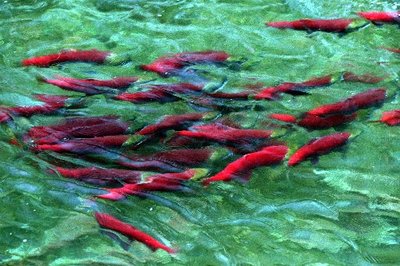forum
library
tutorial
contact

Sockeye Run Picks Up,
Could Be Fourth Largest Since 1980
by Staff
Columbia Basin Bulletin, July 15, 2011
|
the film forum library tutorial contact |

|
Sockeye Run Picks Up,
by Staff
|
Over 2,000 Snake River Fish Forecasted
 The 2011 Columbia River basin sockeye salmon run was late arriving but has developed into a strong and steady stream of fish that will likely be the fourth largest on a record dating back to 1980.
The 2011 Columbia River basin sockeye salmon run was late arriving but has developed into a strong and steady stream of fish that will likely be the fourth largest on a record dating back to 1980.
The Technical Advisory Team on Monday updated its forecast for the sockeye run to 181,500 adult fish to the mouth of the Columbia. That's up from a preseason forecast of 161,900. Most of the sockeye are headed for the Wenatchee and Okanagan river basins in central Washington and/or British Columbia but a small share are native to central Idaho's high country.
The preseason forecast included an anticipated return of 2,100 of the Idaho fish -- Snake River sockeye that swim 900 miles up the Columbia, Snake and Salmon rivers to spawn. The Snake River sockeye are listed as endangered under the Endangered Species Act. The Wenatchee and Okanogan fish, which swim up the Columbia before turning off into their home streams, are not listed.
If the sockeye return to the mouth matches the new forecast, which seems likely, it would rank behind only last year's record total of 387,858, 214,402 in 2008 and 200,724 in 1985.
The total sockeye count at the Columbia's Bonneville Dam (river mile 146) through Wednesday had already reached 173,476 with the pulse still strong. Tuesday's count was 3,329 and Wednesday's was 3,139. The daily counts peaked at 11,685 on July 3 and have been steadily declining since a count of 8,084 on July 6.
There had been through Sunday 1,488 sockeye kept and 368 caught and released by anglers and 53 sockeye netted by commercial fishers below Bonneville. In addition a total of 52 sockeye were caught during two eight-hour non-tribal commercial fisheries in the lower (below Bonneville) river.
TAC members estimate that the sockeye run has made its upriver return about 5-7 days later than the historic average. The Oregon Department of Fish and Wildlife's John North, a TAC member, said that the latest forecast could be conservative.
"It's hard to know how long this tail (of the sockeye run) will last," North said.
TAC, which is comprised of federal, state and tribal fishery officials, also raised its forecast for upper Columbia summer chinook salmon to 80,000 adults to the mouth of the Columbia. TAC had downgraded the summer chinook forecast from the preseason estimate of 91,100 to 77,000 but relatively strong counts for this time in the season allowed a slight increase in the forecast.
Chinook passing Bonneville from June 16 through July 31 are considered upper Columbia summer chinook. The summer chinook stock is not listed and is considered healthy. Upper Columbia summer chinook are destined for areas above Priest Rapids Dam.
Through Wednesday 55,636 adult upper Columbia summer chinook had passed Bonneville. The peak count this year was 2,848 on June 27. Wednesday's count was 927.
According to a July 13 fact sheet prepared by the ODFW and Washington Department of Fish and Wildlife staffs, a total of 5,076 chinook were harvested during those two commercial fisheries and anglers had caught and kept 4,800 and released 2,401 summer chinook in the lower Columbia through July 10. That chinook catch came during an estimated 51,841 angler trips to the lower river since June 16.
The catch between Bonneville and the mid-Columbia's Priest Rapids Dam was 116 kept chinook and 217 kept sockeye during 1,832 angler trips. A total of 96 chinook and 80 sockeye were released, according to state data.
learn more on topics covered in the film
see the video
read the script
learn the songs
discussion forum
